Enhancing Organisational Performance through HPT Assessment
VerifiedAdded on 2020/11/12
|17
|4319
|491
AI Summary
The provided text discusses the application of Human Performance Technology (HPT) in assessing employee performance, leading to improved organisational performance and increased employee capabilities. The text references various sources on social work, critical reflection, learning organisations, compassion recognition schemes, public sector performance management, knowledge management, training instruments, entrepreneurial leadership, continuous learning, and team-based development programmes. It highlights the benefits of engaging teams in HPT assessment processes, including increased employee engagement through effective performance management.
Contribute Materials
Your contribution can guide someone’s learning journey. Share your
documents today.
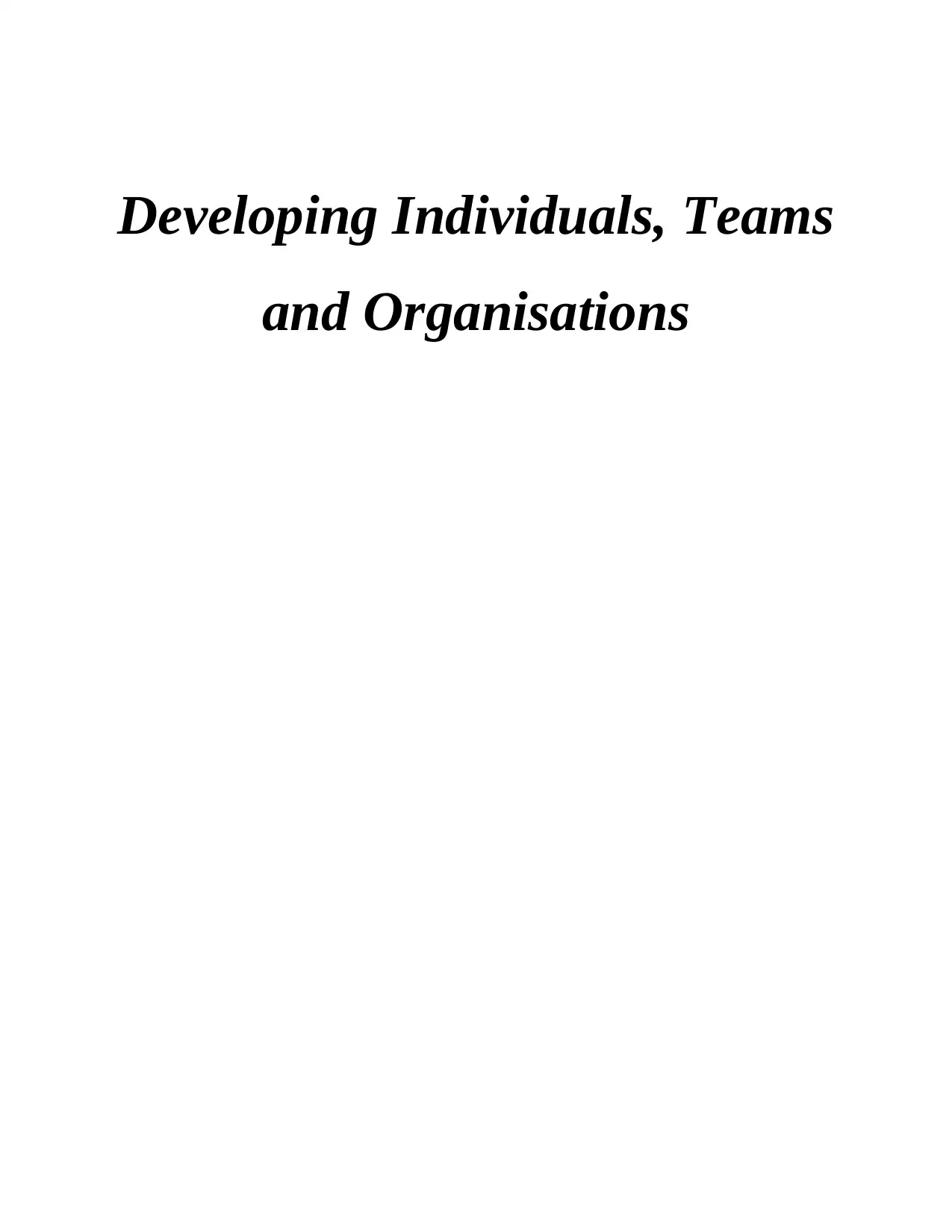
Developing Individuals, Teams
and Organisations
and Organisations
Secure Best Marks with AI Grader
Need help grading? Try our AI Grader for instant feedback on your assignments.
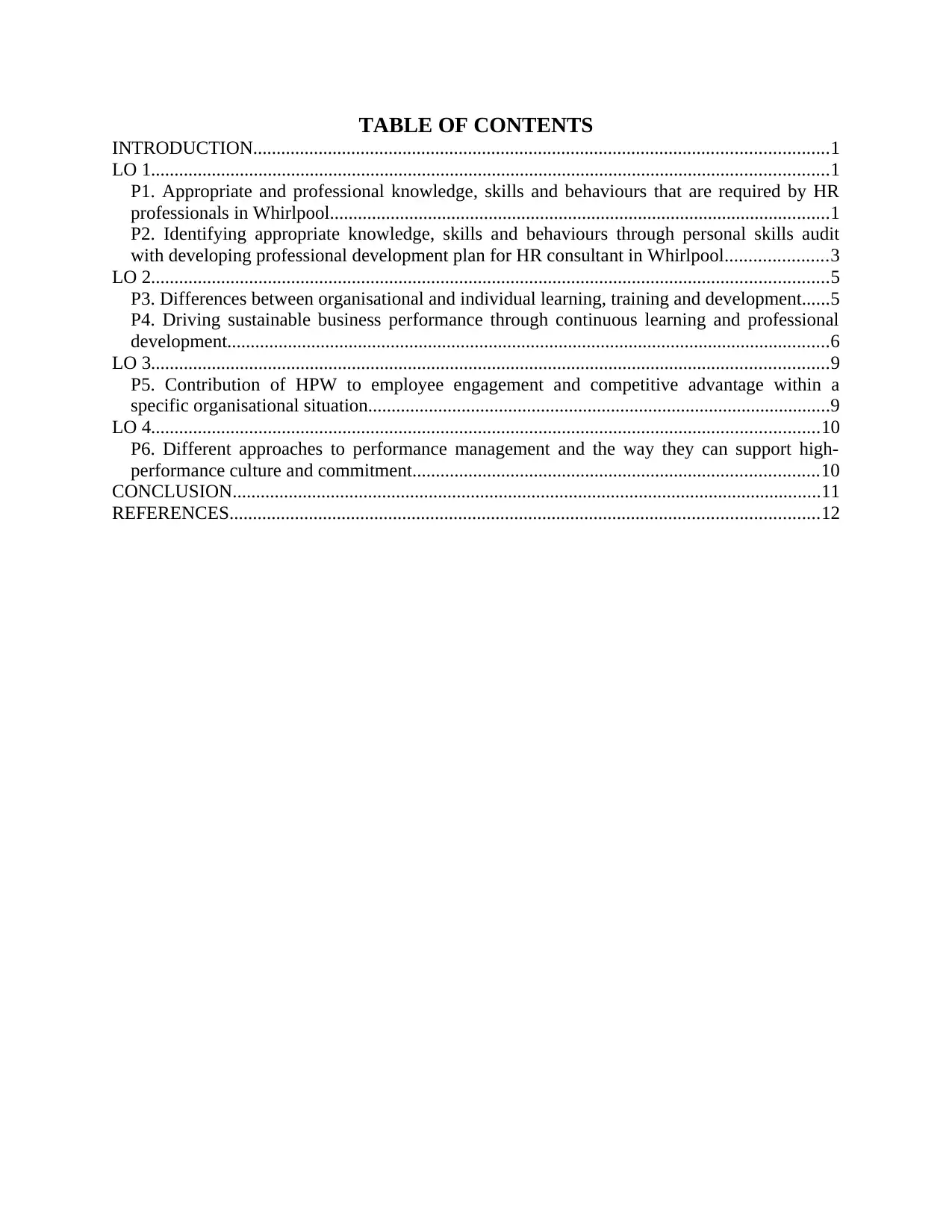
TABLE OF CONTENTS
INTRODUCTION...........................................................................................................................1
LO 1.................................................................................................................................................1
P1. Appropriate and professional knowledge, skills and behaviours that are required by HR
professionals in Whirlpool...........................................................................................................1
P2. Identifying appropriate knowledge, skills and behaviours through personal skills audit
with developing professional development plan for HR consultant in Whirlpool......................3
LO 2.................................................................................................................................................5
P3. Differences between organisational and individual learning, training and development......5
P4. Driving sustainable business performance through continuous learning and professional
development.................................................................................................................................6
LO 3.................................................................................................................................................9
P5. Contribution of HPW to employee engagement and competitive advantage within a
specific organisational situation...................................................................................................9
LO 4...............................................................................................................................................10
P6. Different approaches to performance management and the way they can support high-
performance culture and commitment.......................................................................................10
CONCLUSION..............................................................................................................................11
REFERENCES..............................................................................................................................12
INTRODUCTION...........................................................................................................................1
LO 1.................................................................................................................................................1
P1. Appropriate and professional knowledge, skills and behaviours that are required by HR
professionals in Whirlpool...........................................................................................................1
P2. Identifying appropriate knowledge, skills and behaviours through personal skills audit
with developing professional development plan for HR consultant in Whirlpool......................3
LO 2.................................................................................................................................................5
P3. Differences between organisational and individual learning, training and development......5
P4. Driving sustainable business performance through continuous learning and professional
development.................................................................................................................................6
LO 3.................................................................................................................................................9
P5. Contribution of HPW to employee engagement and competitive advantage within a
specific organisational situation...................................................................................................9
LO 4...............................................................................................................................................10
P6. Different approaches to performance management and the way they can support high-
performance culture and commitment.......................................................................................10
CONCLUSION..............................................................................................................................11
REFERENCES..............................................................................................................................12

LIST OF FIGURES
Figure 1: The Experiential Learning Cycle.....................................................................................7
Figure 2: Kolb's Learning Styles.....................................................................................................8
Figure 1: The Experiential Learning Cycle.....................................................................................7
Figure 2: Kolb's Learning Styles.....................................................................................................8
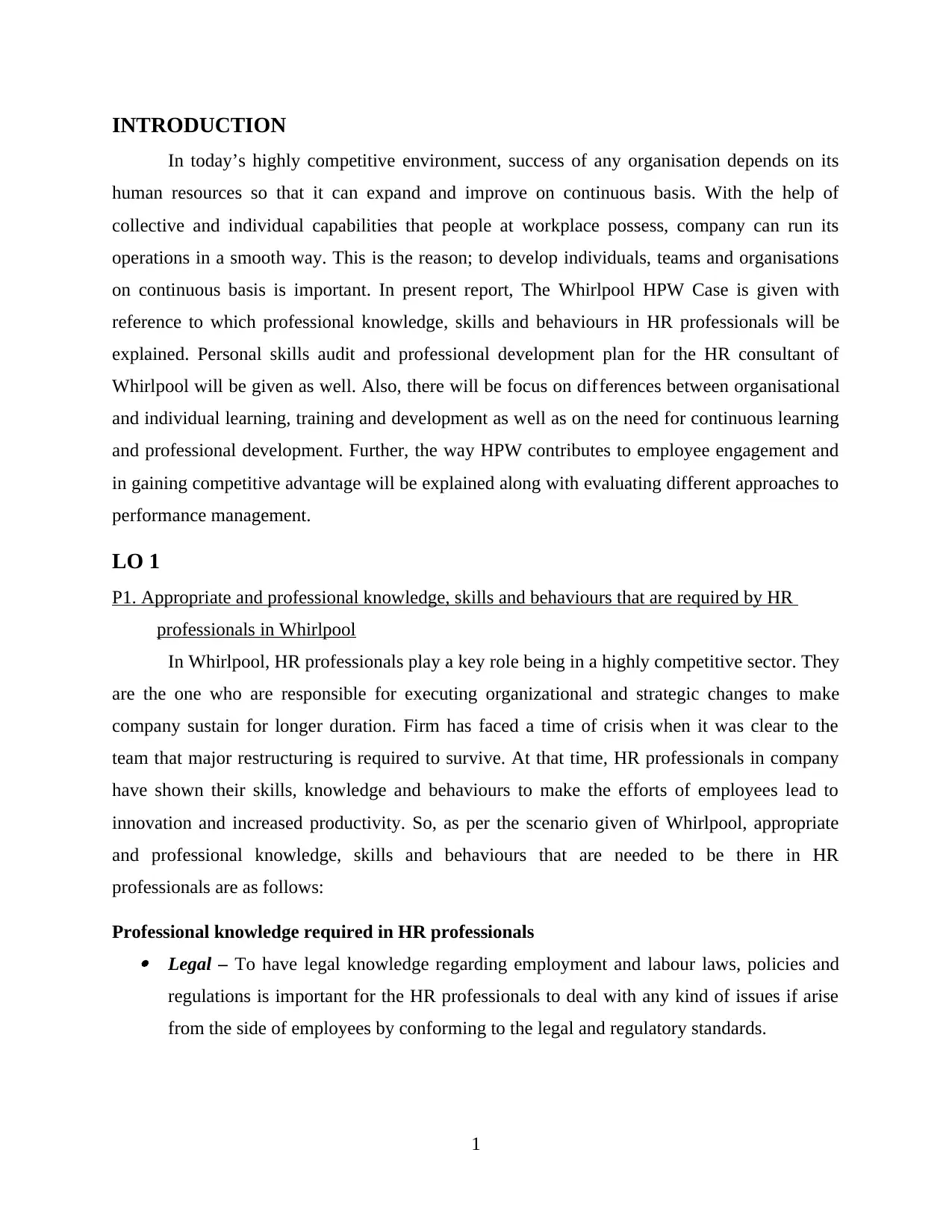
INTRODUCTION
In today’s highly competitive environment, success of any organisation depends on its
human resources so that it can expand and improve on continuous basis. With the help of
collective and individual capabilities that people at workplace possess, company can run its
operations in a smooth way. This is the reason; to develop individuals, teams and organisations
on continuous basis is important. In present report, The Whirlpool HPW Case is given with
reference to which professional knowledge, skills and behaviours in HR professionals will be
explained. Personal skills audit and professional development plan for the HR consultant of
Whirlpool will be given as well. Also, there will be focus on differences between organisational
and individual learning, training and development as well as on the need for continuous learning
and professional development. Further, the way HPW contributes to employee engagement and
in gaining competitive advantage will be explained along with evaluating different approaches to
performance management.
LO 1
P1. Appropriate and professional knowledge, skills and behaviours that are required by HR
professionals in Whirlpool
In Whirlpool, HR professionals play a key role being in a highly competitive sector. They
are the one who are responsible for executing organizational and strategic changes to make
company sustain for longer duration. Firm has faced a time of crisis when it was clear to the
team that major restructuring is required to survive. At that time, HR professionals in company
have shown their skills, knowledge and behaviours to make the efforts of employees lead to
innovation and increased productivity. So, as per the scenario given of Whirlpool, appropriate
and professional knowledge, skills and behaviours that are needed to be there in HR
professionals are as follows:
Professional knowledge required in HR professionals Legal – To have legal knowledge regarding employment and labour laws, policies and
regulations is important for the HR professionals to deal with any kind of issues if arise
from the side of employees by conforming to the legal and regulatory standards.
1
In today’s highly competitive environment, success of any organisation depends on its
human resources so that it can expand and improve on continuous basis. With the help of
collective and individual capabilities that people at workplace possess, company can run its
operations in a smooth way. This is the reason; to develop individuals, teams and organisations
on continuous basis is important. In present report, The Whirlpool HPW Case is given with
reference to which professional knowledge, skills and behaviours in HR professionals will be
explained. Personal skills audit and professional development plan for the HR consultant of
Whirlpool will be given as well. Also, there will be focus on differences between organisational
and individual learning, training and development as well as on the need for continuous learning
and professional development. Further, the way HPW contributes to employee engagement and
in gaining competitive advantage will be explained along with evaluating different approaches to
performance management.
LO 1
P1. Appropriate and professional knowledge, skills and behaviours that are required by HR
professionals in Whirlpool
In Whirlpool, HR professionals play a key role being in a highly competitive sector. They
are the one who are responsible for executing organizational and strategic changes to make
company sustain for longer duration. Firm has faced a time of crisis when it was clear to the
team that major restructuring is required to survive. At that time, HR professionals in company
have shown their skills, knowledge and behaviours to make the efforts of employees lead to
innovation and increased productivity. So, as per the scenario given of Whirlpool, appropriate
and professional knowledge, skills and behaviours that are needed to be there in HR
professionals are as follows:
Professional knowledge required in HR professionals Legal – To have legal knowledge regarding employment and labour laws, policies and
regulations is important for the HR professionals to deal with any kind of issues if arise
from the side of employees by conforming to the legal and regulatory standards.
1
Secure Best Marks with AI Grader
Need help grading? Try our AI Grader for instant feedback on your assignments.
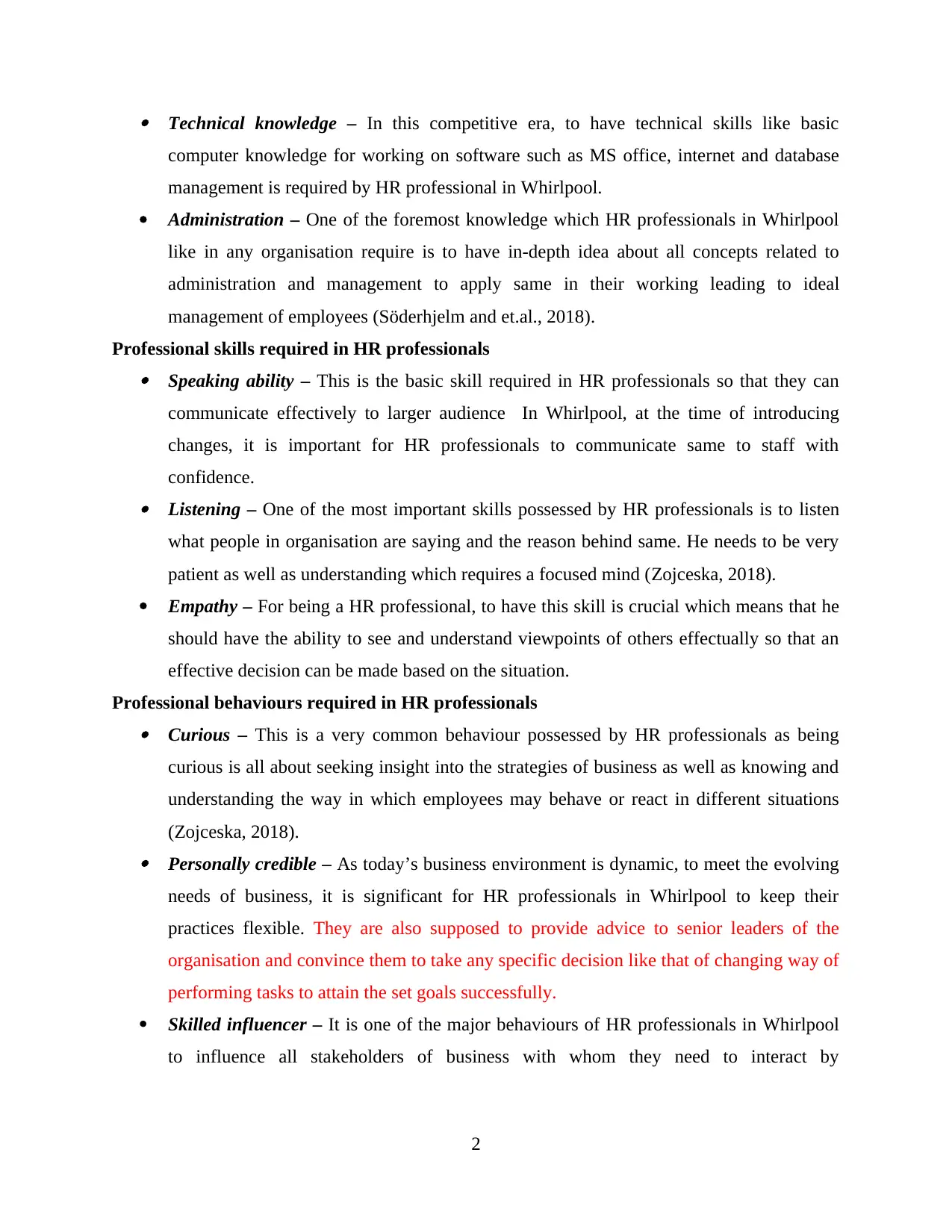
Technical knowledge – In this competitive era, to have technical skills like basic
computer knowledge for working on software such as MS office, internet and database
management is required by HR professional in Whirlpool.
Administration – One of the foremost knowledge which HR professionals in Whirlpool
like in any organisation require is to have in-depth idea about all concepts related to
administration and management to apply same in their working leading to ideal
management of employees (Söderhjelm and et.al., 2018).
Professional skills required in HR professionals Speaking ability – This is the basic skill required in HR professionals so that they can
communicate effectively to larger audience In Whirlpool, at the time of introducing
changes, it is important for HR professionals to communicate same to staff with
confidence. Listening – One of the most important skills possessed by HR professionals is to listen
what people in organisation are saying and the reason behind same. He needs to be very
patient as well as understanding which requires a focused mind (Zojceska, 2018).
Empathy – For being a HR professional, to have this skill is crucial which means that he
should have the ability to see and understand viewpoints of others effectually so that an
effective decision can be made based on the situation.
Professional behaviours required in HR professionals Curious – This is a very common behaviour possessed by HR professionals as being
curious is all about seeking insight into the strategies of business as well as knowing and
understanding the way in which employees may behave or react in different situations
(Zojceska, 2018). Personally credible – As today’s business environment is dynamic, to meet the evolving
needs of business, it is significant for HR professionals in Whirlpool to keep their
practices flexible. They are also supposed to provide advice to senior leaders of the
organisation and convince them to take any specific decision like that of changing way of
performing tasks to attain the set goals successfully.
Skilled influencer – It is one of the major behaviours of HR professionals in Whirlpool
to influence all stakeholders of business with whom they need to interact by
2
computer knowledge for working on software such as MS office, internet and database
management is required by HR professional in Whirlpool.
Administration – One of the foremost knowledge which HR professionals in Whirlpool
like in any organisation require is to have in-depth idea about all concepts related to
administration and management to apply same in their working leading to ideal
management of employees (Söderhjelm and et.al., 2018).
Professional skills required in HR professionals Speaking ability – This is the basic skill required in HR professionals so that they can
communicate effectively to larger audience In Whirlpool, at the time of introducing
changes, it is important for HR professionals to communicate same to staff with
confidence. Listening – One of the most important skills possessed by HR professionals is to listen
what people in organisation are saying and the reason behind same. He needs to be very
patient as well as understanding which requires a focused mind (Zojceska, 2018).
Empathy – For being a HR professional, to have this skill is crucial which means that he
should have the ability to see and understand viewpoints of others effectually so that an
effective decision can be made based on the situation.
Professional behaviours required in HR professionals Curious – This is a very common behaviour possessed by HR professionals as being
curious is all about seeking insight into the strategies of business as well as knowing and
understanding the way in which employees may behave or react in different situations
(Zojceska, 2018). Personally credible – As today’s business environment is dynamic, to meet the evolving
needs of business, it is significant for HR professionals in Whirlpool to keep their
practices flexible. They are also supposed to provide advice to senior leaders of the
organisation and convince them to take any specific decision like that of changing way of
performing tasks to attain the set goals successfully.
Skilled influencer – It is one of the major behaviours of HR professionals in Whirlpool
to influence all stakeholders of business with whom they need to interact by
2
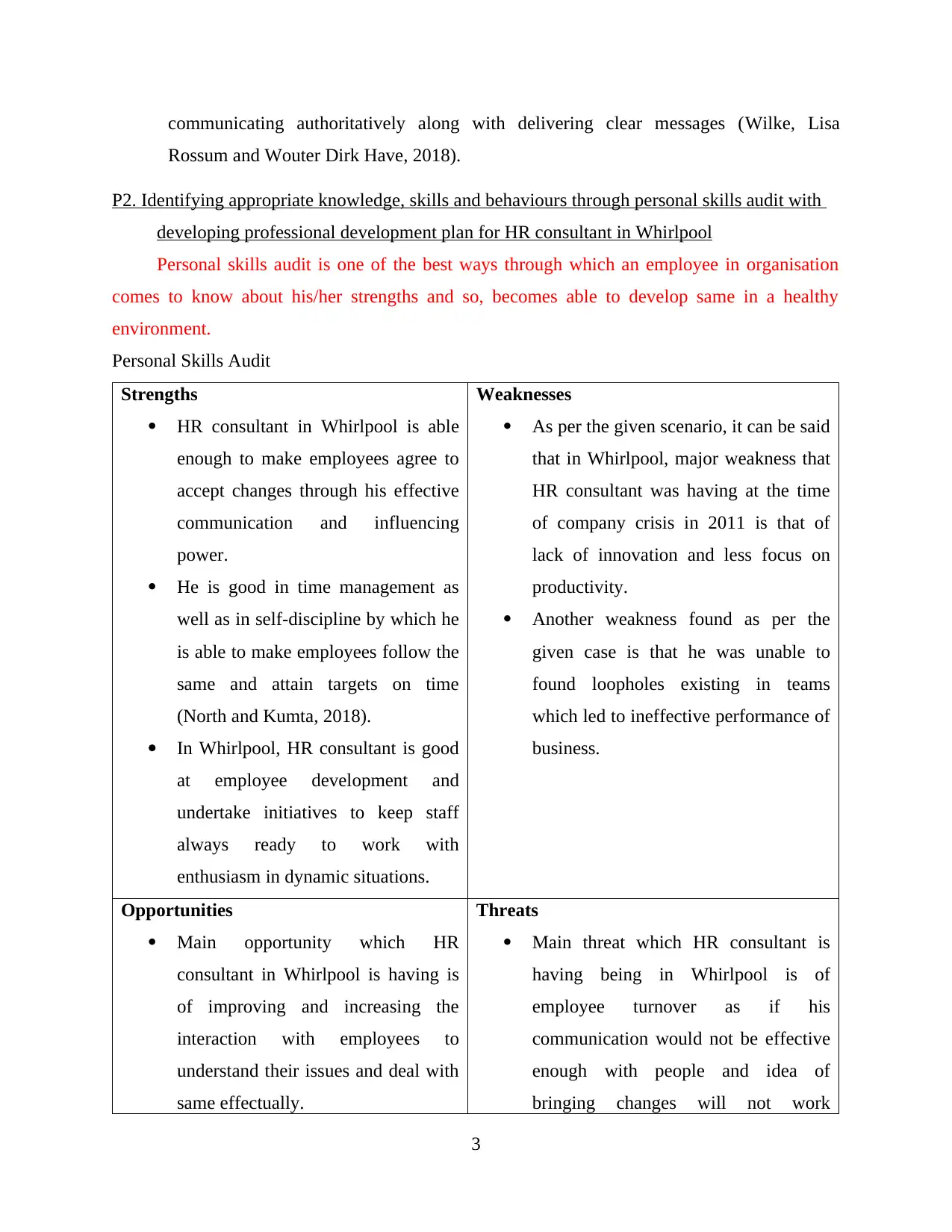
communicating authoritatively along with delivering clear messages (Wilke, Lisa
Rossum and Wouter Dirk Have, 2018).
P2. Identifying appropriate knowledge, skills and behaviours through personal skills audit with
developing professional development plan for HR consultant in Whirlpool
Personal skills audit is one of the best ways through which an employee in organisation
comes to know about his/her strengths and so, becomes able to develop same in a healthy
environment.
Personal Skills Audit
Strengths
HR consultant in Whirlpool is able
enough to make employees agree to
accept changes through his effective
communication and influencing
power.
He is good in time management as
well as in self-discipline by which he
is able to make employees follow the
same and attain targets on time
(North and Kumta, 2018).
In Whirlpool, HR consultant is good
at employee development and
undertake initiatives to keep staff
always ready to work with
enthusiasm in dynamic situations.
Weaknesses
As per the given scenario, it can be said
that in Whirlpool, major weakness that
HR consultant was having at the time
of company crisis in 2011 is that of
lack of innovation and less focus on
productivity.
Another weakness found as per the
given case is that he was unable to
found loopholes existing in teams
which led to ineffective performance of
business.
Opportunities
Main opportunity which HR
consultant in Whirlpool is having is
of improving and increasing the
interaction with employees to
understand their issues and deal with
same effectually.
Threats
Main threat which HR consultant is
having being in Whirlpool is of
employee turnover as if his
communication would not be effective
enough with people and idea of
bringing changes will not work
3
Rossum and Wouter Dirk Have, 2018).
P2. Identifying appropriate knowledge, skills and behaviours through personal skills audit with
developing professional development plan for HR consultant in Whirlpool
Personal skills audit is one of the best ways through which an employee in organisation
comes to know about his/her strengths and so, becomes able to develop same in a healthy
environment.
Personal Skills Audit
Strengths
HR consultant in Whirlpool is able
enough to make employees agree to
accept changes through his effective
communication and influencing
power.
He is good in time management as
well as in self-discipline by which he
is able to make employees follow the
same and attain targets on time
(North and Kumta, 2018).
In Whirlpool, HR consultant is good
at employee development and
undertake initiatives to keep staff
always ready to work with
enthusiasm in dynamic situations.
Weaknesses
As per the given scenario, it can be said
that in Whirlpool, major weakness that
HR consultant was having at the time
of company crisis in 2011 is that of
lack of innovation and less focus on
productivity.
Another weakness found as per the
given case is that he was unable to
found loopholes existing in teams
which led to ineffective performance of
business.
Opportunities
Main opportunity which HR
consultant in Whirlpool is having is
of improving and increasing the
interaction with employees to
understand their issues and deal with
same effectually.
Threats
Main threat which HR consultant is
having being in Whirlpool is of
employee turnover as if his
communication would not be effective
enough with people and idea of
bringing changes will not work
3
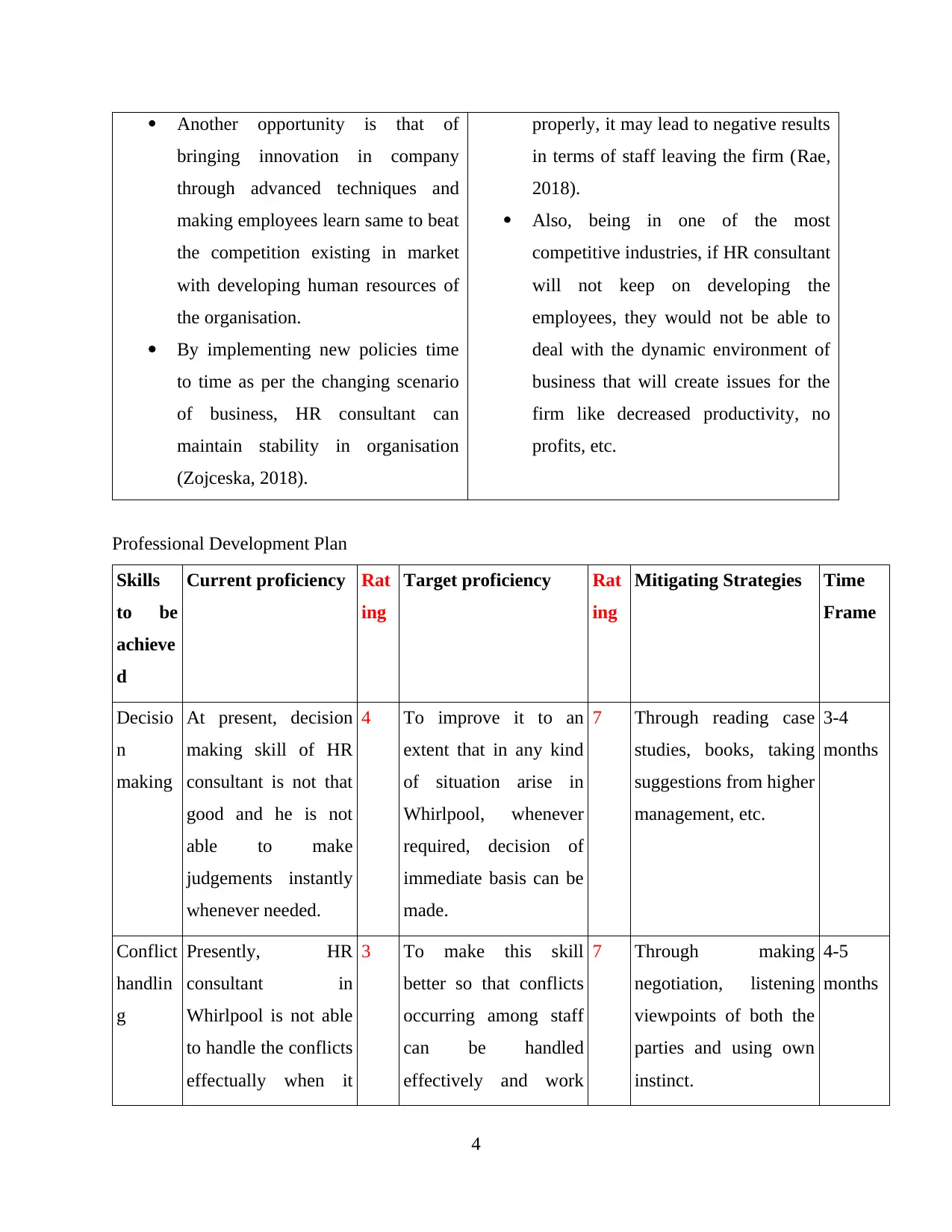
Another opportunity is that of
bringing innovation in company
through advanced techniques and
making employees learn same to beat
the competition existing in market
with developing human resources of
the organisation.
By implementing new policies time
to time as per the changing scenario
of business, HR consultant can
maintain stability in organisation
(Zojceska, 2018).
properly, it may lead to negative results
in terms of staff leaving the firm (Rae,
2018).
Also, being in one of the most
competitive industries, if HR consultant
will not keep on developing the
employees, they would not be able to
deal with the dynamic environment of
business that will create issues for the
firm like decreased productivity, no
profits, etc.
Professional Development Plan
Skills
to be
achieve
d
Current proficiency Rat
ing
Target proficiency Rat
ing
Mitigating Strategies Time
Frame
Decisio
n
making
At present, decision
making skill of HR
consultant is not that
good and he is not
able to make
judgements instantly
whenever needed.
4 To improve it to an
extent that in any kind
of situation arise in
Whirlpool, whenever
required, decision of
immediate basis can be
made.
7 Through reading case
studies, books, taking
suggestions from higher
management, etc.
3-4
months
Conflict
handlin
g
Presently, HR
consultant in
Whirlpool is not able
to handle the conflicts
effectually when it
3 To make this skill
better so that conflicts
occurring among staff
can be handled
effectively and work
7 Through making
negotiation, listening
viewpoints of both the
parties and using own
instinct.
4-5
months
4
bringing innovation in company
through advanced techniques and
making employees learn same to beat
the competition existing in market
with developing human resources of
the organisation.
By implementing new policies time
to time as per the changing scenario
of business, HR consultant can
maintain stability in organisation
(Zojceska, 2018).
properly, it may lead to negative results
in terms of staff leaving the firm (Rae,
2018).
Also, being in one of the most
competitive industries, if HR consultant
will not keep on developing the
employees, they would not be able to
deal with the dynamic environment of
business that will create issues for the
firm like decreased productivity, no
profits, etc.
Professional Development Plan
Skills
to be
achieve
d
Current proficiency Rat
ing
Target proficiency Rat
ing
Mitigating Strategies Time
Frame
Decisio
n
making
At present, decision
making skill of HR
consultant is not that
good and he is not
able to make
judgements instantly
whenever needed.
4 To improve it to an
extent that in any kind
of situation arise in
Whirlpool, whenever
required, decision of
immediate basis can be
made.
7 Through reading case
studies, books, taking
suggestions from higher
management, etc.
3-4
months
Conflict
handlin
g
Presently, HR
consultant in
Whirlpool is not able
to handle the conflicts
effectually when it
3 To make this skill
better so that conflicts
occurring among staff
can be handled
effectively and work
7 Through making
negotiation, listening
viewpoints of both the
parties and using own
instinct.
4-5
months
4
Paraphrase This Document
Need a fresh take? Get an instant paraphrase of this document with our AI Paraphraser
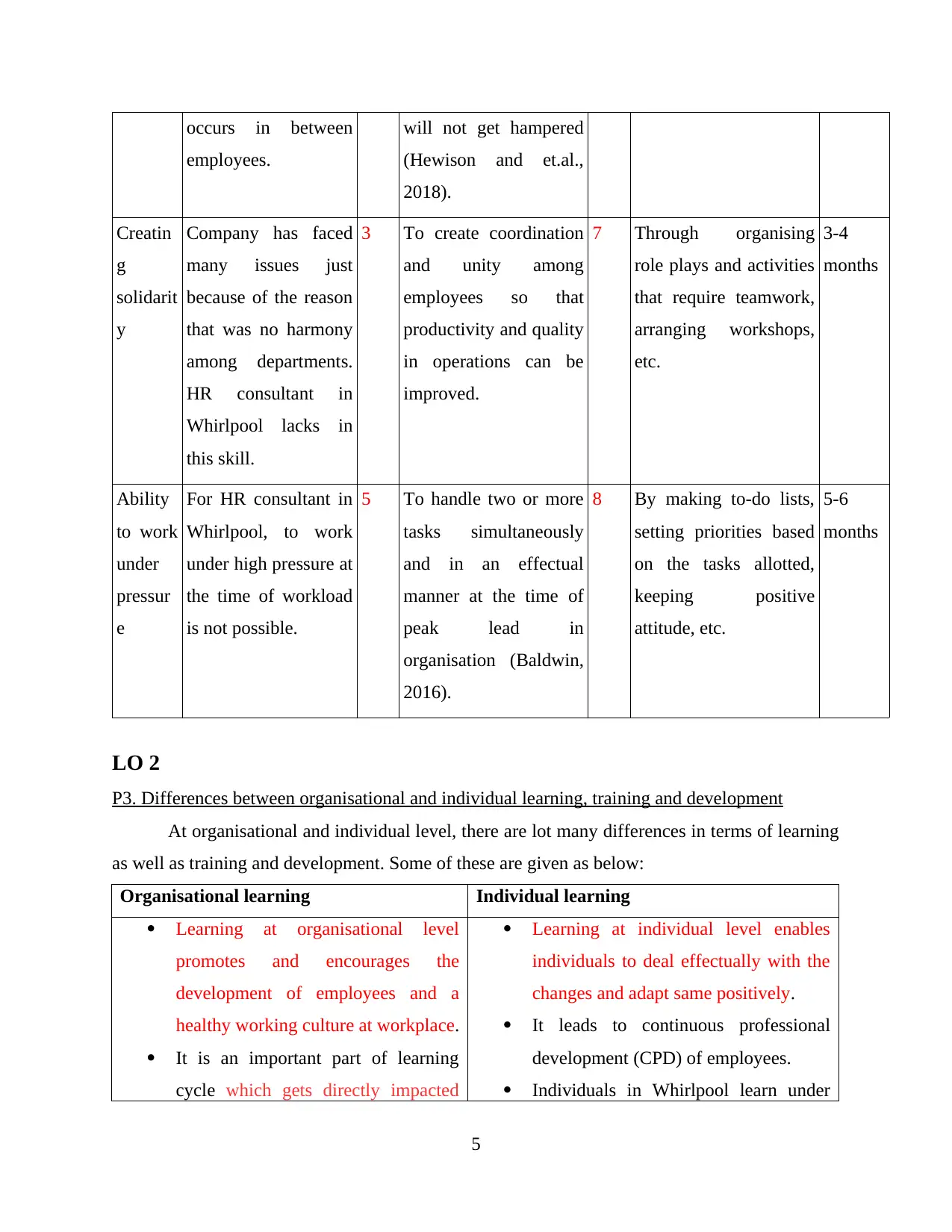
occurs in between
employees.
will not get hampered
(Hewison and et.al.,
2018).
Creatin
g
solidarit
y
Company has faced
many issues just
because of the reason
that was no harmony
among departments.
HR consultant in
Whirlpool lacks in
this skill.
3 To create coordination
and unity among
employees so that
productivity and quality
in operations can be
improved.
7 Through organising
role plays and activities
that require teamwork,
arranging workshops,
etc.
3-4
months
Ability
to work
under
pressur
e
For HR consultant in
Whirlpool, to work
under high pressure at
the time of workload
is not possible.
5 To handle two or more
tasks simultaneously
and in an effectual
manner at the time of
peak lead in
organisation (Baldwin,
2016).
8 By making to-do lists,
setting priorities based
on the tasks allotted,
keeping positive
attitude, etc.
5-6
months
LO 2
P3. Differences between organisational and individual learning, training and development
At organisational and individual level, there are lot many differences in terms of learning
as well as training and development. Some of these are given as below:
Organisational learning Individual learning
Learning at organisational level
promotes and encourages the
development of employees and a
healthy working culture at workplace.
It is an important part of learning
cycle which gets directly impacted
Learning at individual level enables
individuals to deal effectually with the
changes and adapt same positively.
It leads to continuous professional
development (CPD) of employees.
Individuals in Whirlpool learn under
5
employees.
will not get hampered
(Hewison and et.al.,
2018).
Creatin
g
solidarit
y
Company has faced
many issues just
because of the reason
that was no harmony
among departments.
HR consultant in
Whirlpool lacks in
this skill.
3 To create coordination
and unity among
employees so that
productivity and quality
in operations can be
improved.
7 Through organising
role plays and activities
that require teamwork,
arranging workshops,
etc.
3-4
months
Ability
to work
under
pressur
e
For HR consultant in
Whirlpool, to work
under high pressure at
the time of workload
is not possible.
5 To handle two or more
tasks simultaneously
and in an effectual
manner at the time of
peak lead in
organisation (Baldwin,
2016).
8 By making to-do lists,
setting priorities based
on the tasks allotted,
keeping positive
attitude, etc.
5-6
months
LO 2
P3. Differences between organisational and individual learning, training and development
At organisational and individual level, there are lot many differences in terms of learning
as well as training and development. Some of these are given as below:
Organisational learning Individual learning
Learning at organisational level
promotes and encourages the
development of employees and a
healthy working culture at workplace.
It is an important part of learning
cycle which gets directly impacted
Learning at individual level enables
individuals to deal effectually with the
changes and adapt same positively.
It leads to continuous professional
development (CPD) of employees.
Individuals in Whirlpool learn under
5
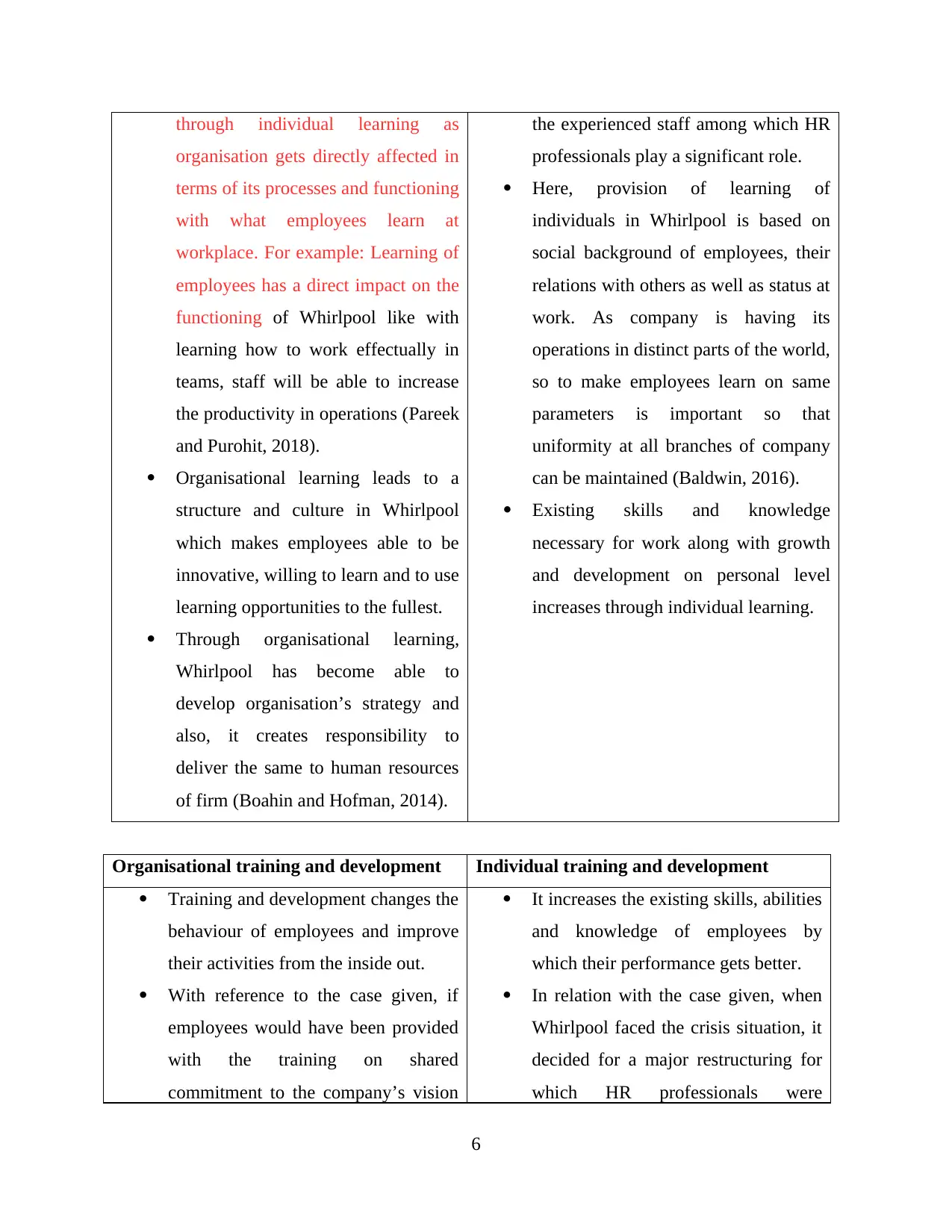
through individual learning as
organisation gets directly affected in
terms of its processes and functioning
with what employees learn at
workplace. For example: Learning of
employees has a direct impact on the
functioning of Whirlpool like with
learning how to work effectually in
teams, staff will be able to increase
the productivity in operations (Pareek
and Purohit, 2018).
Organisational learning leads to a
structure and culture in Whirlpool
which makes employees able to be
innovative, willing to learn and to use
learning opportunities to the fullest.
Through organisational learning,
Whirlpool has become able to
develop organisation’s strategy and
also, it creates responsibility to
deliver the same to human resources
of firm (Boahin and Hofman, 2014).
the experienced staff among which HR
professionals play a significant role.
Here, provision of learning of
individuals in Whirlpool is based on
social background of employees, their
relations with others as well as status at
work. As company is having its
operations in distinct parts of the world,
so to make employees learn on same
parameters is important so that
uniformity at all branches of company
can be maintained (Baldwin, 2016).
Existing skills and knowledge
necessary for work along with growth
and development on personal level
increases through individual learning.
Organisational training and development Individual training and development
Training and development changes the
behaviour of employees and improve
their activities from the inside out.
With reference to the case given, if
employees would have been provided
with the training on shared
commitment to the company’s vision
It increases the existing skills, abilities
and knowledge of employees by
which their performance gets better.
In relation with the case given, when
Whirlpool faced the crisis situation, it
decided for a major restructuring for
which HR professionals were
6
organisation gets directly affected in
terms of its processes and functioning
with what employees learn at
workplace. For example: Learning of
employees has a direct impact on the
functioning of Whirlpool like with
learning how to work effectually in
teams, staff will be able to increase
the productivity in operations (Pareek
and Purohit, 2018).
Organisational learning leads to a
structure and culture in Whirlpool
which makes employees able to be
innovative, willing to learn and to use
learning opportunities to the fullest.
Through organisational learning,
Whirlpool has become able to
develop organisation’s strategy and
also, it creates responsibility to
deliver the same to human resources
of firm (Boahin and Hofman, 2014).
the experienced staff among which HR
professionals play a significant role.
Here, provision of learning of
individuals in Whirlpool is based on
social background of employees, their
relations with others as well as status at
work. As company is having its
operations in distinct parts of the world,
so to make employees learn on same
parameters is important so that
uniformity at all branches of company
can be maintained (Baldwin, 2016).
Existing skills and knowledge
necessary for work along with growth
and development on personal level
increases through individual learning.
Organisational training and development Individual training and development
Training and development changes the
behaviour of employees and improve
their activities from the inside out.
With reference to the case given, if
employees would have been provided
with the training on shared
commitment to the company’s vision
It increases the existing skills, abilities
and knowledge of employees by
which their performance gets better.
In relation with the case given, when
Whirlpool faced the crisis situation, it
decided for a major restructuring for
which HR professionals were
6

transparent communication, as well as
mutual respect and solidarity,
Whirlpool might have not faced crisis
(Hewison and et.al., 2018).
Training and development at
organisational level leads to improve
the performance of business as a
whole resulting in increased profits
and revenues with gaining a
competitive edge over rivalries in the
market.
supposed to provide effective training
and development sessions to
individuals to ensure their improved
performance.
Training and development at
individual level leads to create a
healthy environment at workplace as
with increased skills and knowledge,
employees feel confident and perform
their tasks with effectiveness and
positivity (Pareek and Purohit, 2018).
P4. Driving sustainable business performance through continuous learning and professional
development
According to British Council, CPD can be termed as a process which is used by
organisations for continuous and lifelong development of employees to make them personally
and professionally able to perform their tasks with improved knowledge, skills and practice. In
Whirlpool, there is huge need of continuous learning and professional development so that
sustainability in performance can be gained and business can grow on consistent basis. CPD is
needed in company and it ensures capabilities of employees to keep pace and meet the set
standards of others as well.
Whirlpool can get highly benefitted if it gives due emphasis on continuous learning and
professional development of employees as with the help of this, professional and effective
services can be delivered to customers, clients as well as the community (Boahin and Hofman,
2014). As Whirlpool needs to make their employees trained and deal with the upcoming changes
effectually, CPD is highly important so that a meaningful contribution of team can be gained.
Through CPD, employees gain new possibilities, knowledge and skills which ultimately proves
to be beneficial for Whirlpool to run business in a smooth way.
Need for continuous learning and professional development can be understood with the
help of Kolb’s Learning Styles and Experiential Learning Cycle which if applied in Whirlpool, it
7
mutual respect and solidarity,
Whirlpool might have not faced crisis
(Hewison and et.al., 2018).
Training and development at
organisational level leads to improve
the performance of business as a
whole resulting in increased profits
and revenues with gaining a
competitive edge over rivalries in the
market.
supposed to provide effective training
and development sessions to
individuals to ensure their improved
performance.
Training and development at
individual level leads to create a
healthy environment at workplace as
with increased skills and knowledge,
employees feel confident and perform
their tasks with effectiveness and
positivity (Pareek and Purohit, 2018).
P4. Driving sustainable business performance through continuous learning and professional
development
According to British Council, CPD can be termed as a process which is used by
organisations for continuous and lifelong development of employees to make them personally
and professionally able to perform their tasks with improved knowledge, skills and practice. In
Whirlpool, there is huge need of continuous learning and professional development so that
sustainability in performance can be gained and business can grow on consistent basis. CPD is
needed in company and it ensures capabilities of employees to keep pace and meet the set
standards of others as well.
Whirlpool can get highly benefitted if it gives due emphasis on continuous learning and
professional development of employees as with the help of this, professional and effective
services can be delivered to customers, clients as well as the community (Boahin and Hofman,
2014). As Whirlpool needs to make their employees trained and deal with the upcoming changes
effectually, CPD is highly important so that a meaningful contribution of team can be gained.
Through CPD, employees gain new possibilities, knowledge and skills which ultimately proves
to be beneficial for Whirlpool to run business in a smooth way.
Need for continuous learning and professional development can be understood with the
help of Kolb’s Learning Styles and Experiential Learning Cycle which if applied in Whirlpool, it
7
Secure Best Marks with AI Grader
Need help grading? Try our AI Grader for instant feedback on your assignments.
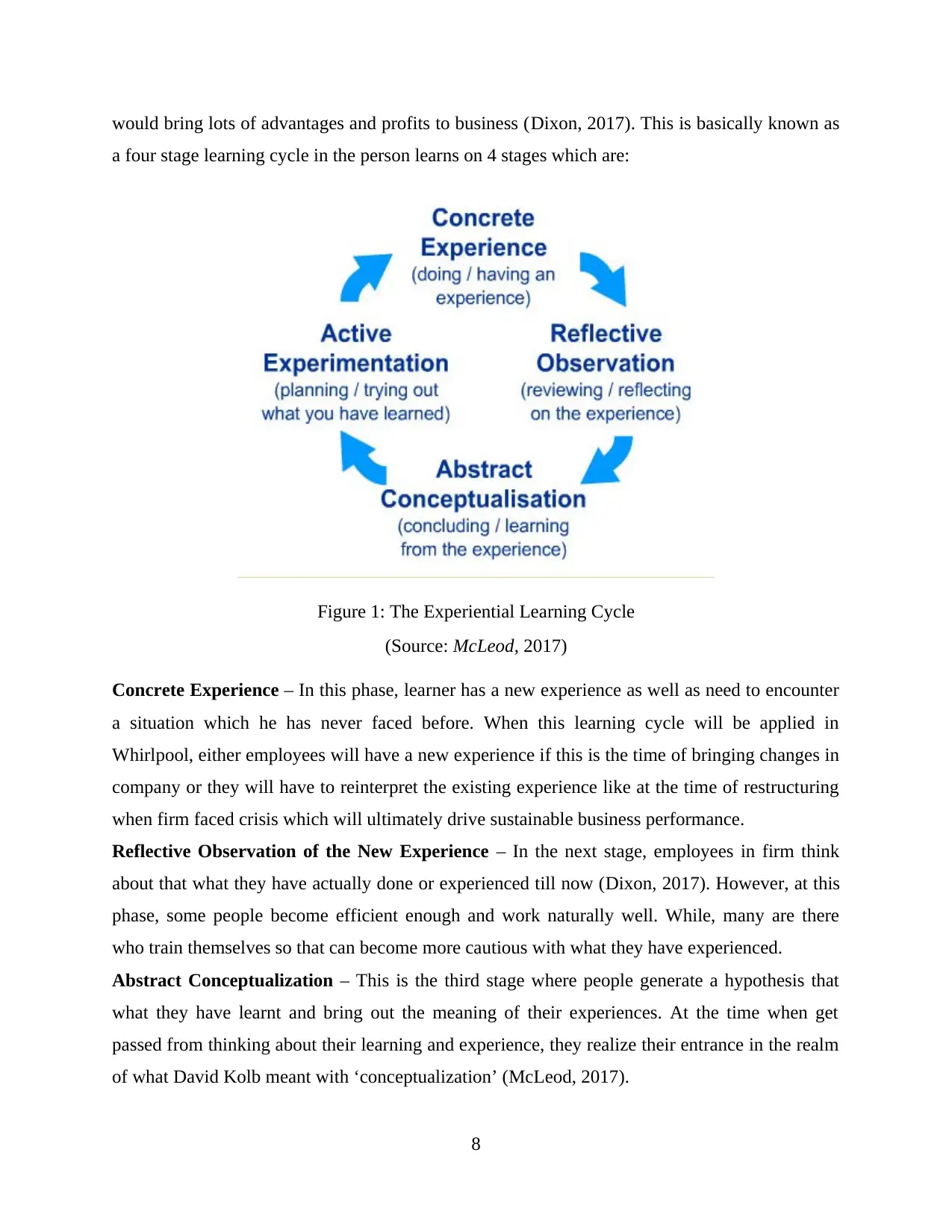
would bring lots of advantages and profits to business (Dixon, 2017). This is basically known as
a four stage learning cycle in the person learns on 4 stages which are:
Figure 1: The Experiential Learning Cycle
(Source: McLeod, 2017)
Concrete Experience – In this phase, learner has a new experience as well as need to encounter
a situation which he has never faced before. When this learning cycle will be applied in
Whirlpool, either employees will have a new experience if this is the time of bringing changes in
company or they will have to reinterpret the existing experience like at the time of restructuring
when firm faced crisis which will ultimately drive sustainable business performance.
Reflective Observation of the New Experience – In the next stage, employees in firm think
about that what they have actually done or experienced till now (Dixon, 2017). However, at this
phase, some people become efficient enough and work naturally well. While, many are there
who train themselves so that can become more cautious with what they have experienced.
Abstract Conceptualization – This is the third stage where people generate a hypothesis that
what they have learnt and bring out the meaning of their experiences. At the time when get
passed from thinking about their learning and experience, they realize their entrance in the realm
of what David Kolb meant with ‘conceptualization’ (McLeod, 2017).
8
a four stage learning cycle in the person learns on 4 stages which are:
Figure 1: The Experiential Learning Cycle
(Source: McLeod, 2017)
Concrete Experience – In this phase, learner has a new experience as well as need to encounter
a situation which he has never faced before. When this learning cycle will be applied in
Whirlpool, either employees will have a new experience if this is the time of bringing changes in
company or they will have to reinterpret the existing experience like at the time of restructuring
when firm faced crisis which will ultimately drive sustainable business performance.
Reflective Observation of the New Experience – In the next stage, employees in firm think
about that what they have actually done or experienced till now (Dixon, 2017). However, at this
phase, some people become efficient enough and work naturally well. While, many are there
who train themselves so that can become more cautious with what they have experienced.
Abstract Conceptualization – This is the third stage where people generate a hypothesis that
what they have learnt and bring out the meaning of their experiences. At the time when get
passed from thinking about their learning and experience, they realize their entrance in the realm
of what David Kolb meant with ‘conceptualization’ (McLeod, 2017).
8

Active Experimentation – This is the last stage of Experiential Learning Cycle where people
effectively test hypothesis that they have made in the previous phase. Here, they come to know
that whether their new experiences will support them in performing tasks or prove to be a
challenge.
As per the approach provided by David Kolb, there are four types of learning styles that
enable employees in an organisation to be oriented in accordance with the style as per their
preference. It depends on the situation as well as preference of learner that which learning style
he will choose. These styles are like:
Figure 2: Kolb's Learning Styles
(Source: McLeod, 2017)
Diverging – As per this style, people feel and look at things with their own perspectives. They
are highly sensitive and mainly prefer to watch rather doing the same. These kinds of learners are
good at gathering information first and then using their imagination to find solution for the
problems. If any kind of concrete situation arises in Whirlpool, they will view the same with
several viewpoints. Employees preferring this style prove to be helpful for business at the time of
idea generation and so, will drive sustainable performance.
9
effectively test hypothesis that they have made in the previous phase. Here, they come to know
that whether their new experiences will support them in performing tasks or prove to be a
challenge.
As per the approach provided by David Kolb, there are four types of learning styles that
enable employees in an organisation to be oriented in accordance with the style as per their
preference. It depends on the situation as well as preference of learner that which learning style
he will choose. These styles are like:
Figure 2: Kolb's Learning Styles
(Source: McLeod, 2017)
Diverging – As per this style, people feel and look at things with their own perspectives. They
are highly sensitive and mainly prefer to watch rather doing the same. These kinds of learners are
good at gathering information first and then using their imagination to find solution for the
problems. If any kind of concrete situation arises in Whirlpool, they will view the same with
several viewpoints. Employees preferring this style prove to be helpful for business at the time of
idea generation and so, will drive sustainable performance.
9
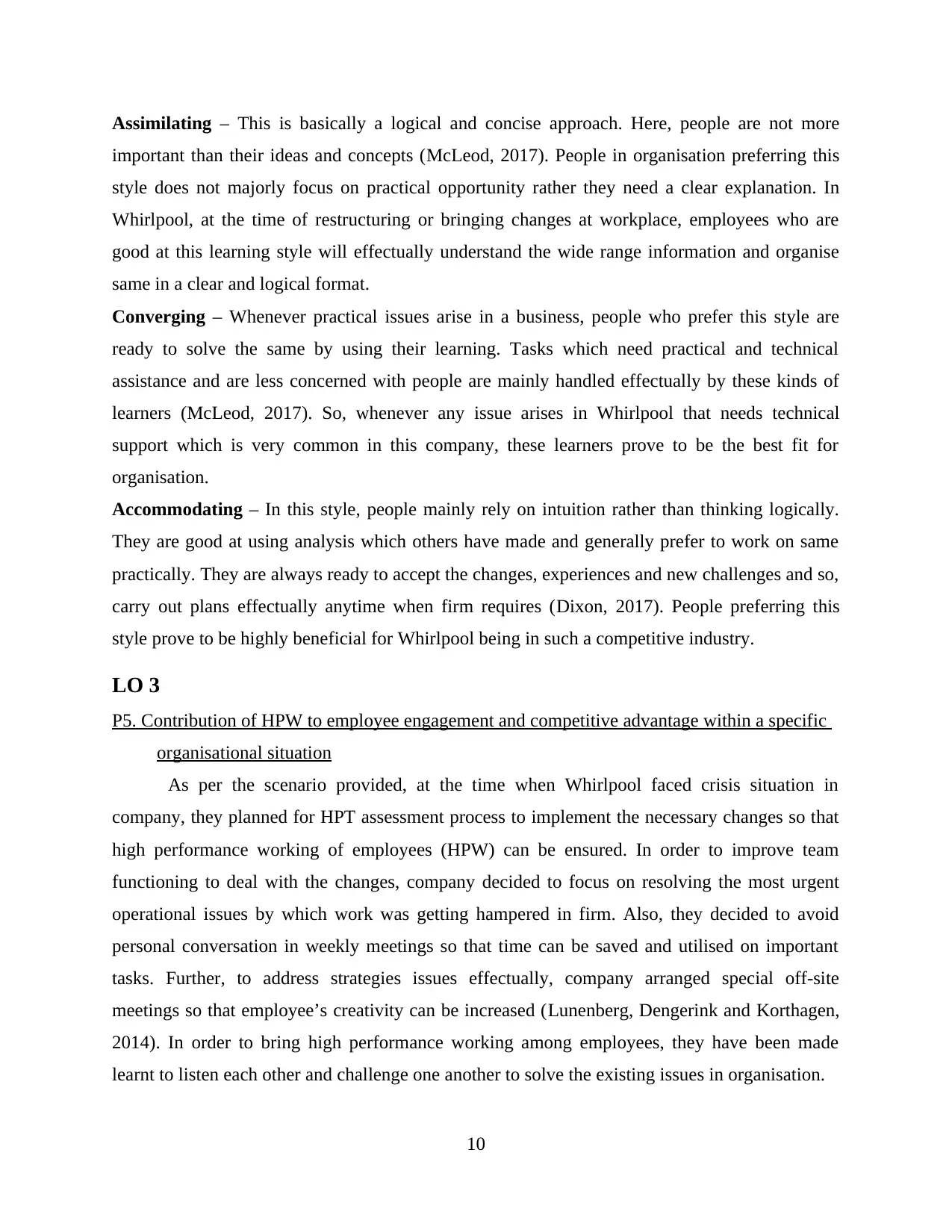
Assimilating – This is basically a logical and concise approach. Here, people are not more
important than their ideas and concepts (McLeod, 2017). People in organisation preferring this
style does not majorly focus on practical opportunity rather they need a clear explanation. In
Whirlpool, at the time of restructuring or bringing changes at workplace, employees who are
good at this learning style will effectually understand the wide range information and organise
same in a clear and logical format.
Converging – Whenever practical issues arise in a business, people who prefer this style are
ready to solve the same by using their learning. Tasks which need practical and technical
assistance and are less concerned with people are mainly handled effectually by these kinds of
learners (McLeod, 2017). So, whenever any issue arises in Whirlpool that needs technical
support which is very common in this company, these learners prove to be the best fit for
organisation.
Accommodating – In this style, people mainly rely on intuition rather than thinking logically.
They are good at using analysis which others have made and generally prefer to work on same
practically. They are always ready to accept the changes, experiences and new challenges and so,
carry out plans effectually anytime when firm requires (Dixon, 2017). People preferring this
style prove to be highly beneficial for Whirlpool being in such a competitive industry.
LO 3
P5. Contribution of HPW to employee engagement and competitive advantage within a specific
organisational situation
As per the scenario provided, at the time when Whirlpool faced crisis situation in
company, they planned for HPT assessment process to implement the necessary changes so that
high performance working of employees (HPW) can be ensured. In order to improve team
functioning to deal with the changes, company decided to focus on resolving the most urgent
operational issues by which work was getting hampered in firm. Also, they decided to avoid
personal conversation in weekly meetings so that time can be saved and utilised on important
tasks. Further, to address strategies issues effectually, company arranged special off-site
meetings so that employee’s creativity can be increased (Lunenberg, Dengerink and Korthagen,
2014). In order to bring high performance working among employees, they have been made
learnt to listen each other and challenge one another to solve the existing issues in organisation.
10
important than their ideas and concepts (McLeod, 2017). People in organisation preferring this
style does not majorly focus on practical opportunity rather they need a clear explanation. In
Whirlpool, at the time of restructuring or bringing changes at workplace, employees who are
good at this learning style will effectually understand the wide range information and organise
same in a clear and logical format.
Converging – Whenever practical issues arise in a business, people who prefer this style are
ready to solve the same by using their learning. Tasks which need practical and technical
assistance and are less concerned with people are mainly handled effectually by these kinds of
learners (McLeod, 2017). So, whenever any issue arises in Whirlpool that needs technical
support which is very common in this company, these learners prove to be the best fit for
organisation.
Accommodating – In this style, people mainly rely on intuition rather than thinking logically.
They are good at using analysis which others have made and generally prefer to work on same
practically. They are always ready to accept the changes, experiences and new challenges and so,
carry out plans effectually anytime when firm requires (Dixon, 2017). People preferring this
style prove to be highly beneficial for Whirlpool being in such a competitive industry.
LO 3
P5. Contribution of HPW to employee engagement and competitive advantage within a specific
organisational situation
As per the scenario provided, at the time when Whirlpool faced crisis situation in
company, they planned for HPT assessment process to implement the necessary changes so that
high performance working of employees (HPW) can be ensured. In order to improve team
functioning to deal with the changes, company decided to focus on resolving the most urgent
operational issues by which work was getting hampered in firm. Also, they decided to avoid
personal conversation in weekly meetings so that time can be saved and utilised on important
tasks. Further, to address strategies issues effectually, company arranged special off-site
meetings so that employee’s creativity can be increased (Lunenberg, Dengerink and Korthagen,
2014). In order to bring high performance working among employees, they have been made
learnt to listen each other and challenge one another to solve the existing issues in organisation.
10
Paraphrase This Document
Need a fresh take? Get an instant paraphrase of this document with our AI Paraphraser
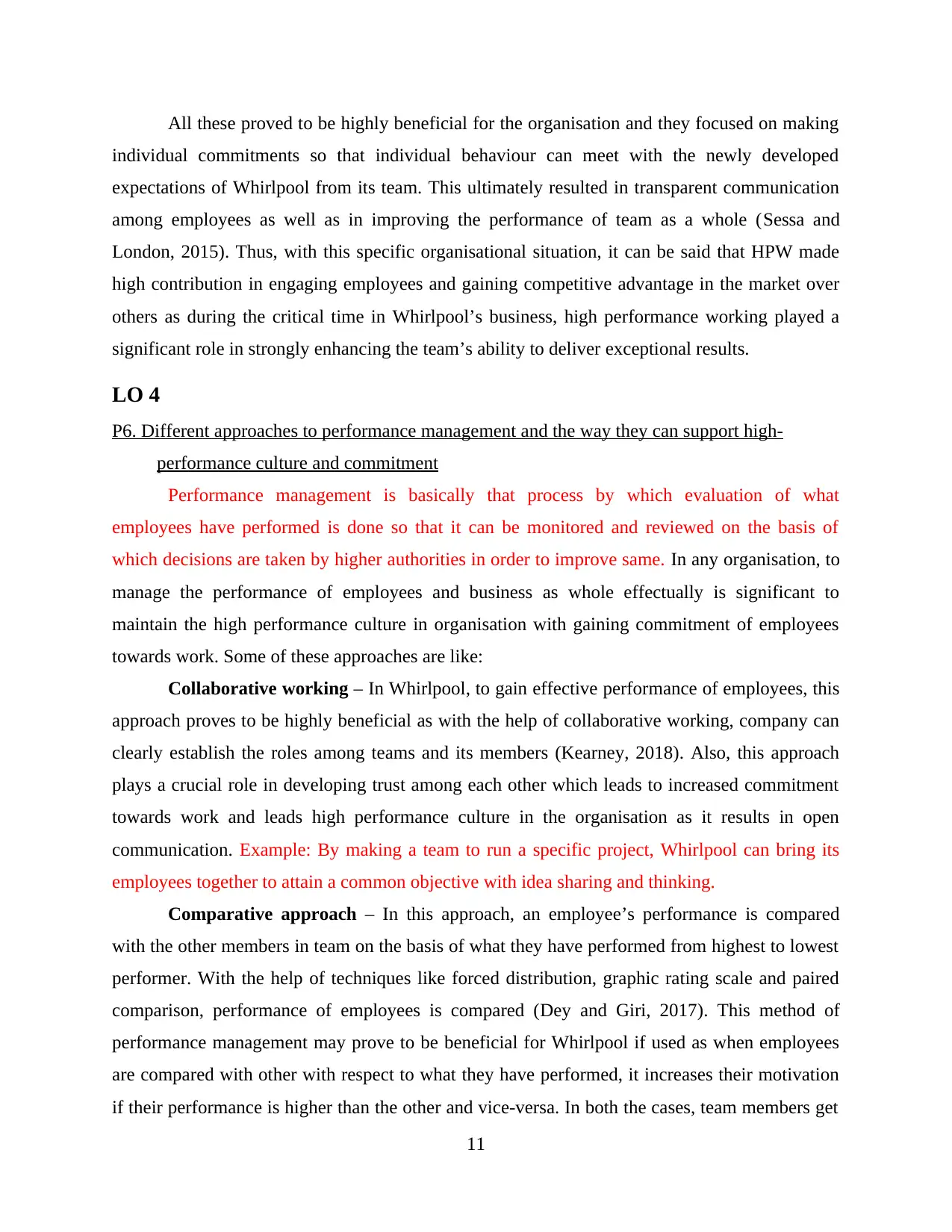
All these proved to be highly beneficial for the organisation and they focused on making
individual commitments so that individual behaviour can meet with the newly developed
expectations of Whirlpool from its team. This ultimately resulted in transparent communication
among employees as well as in improving the performance of team as a whole (Sessa and
London, 2015). Thus, with this specific organisational situation, it can be said that HPW made
high contribution in engaging employees and gaining competitive advantage in the market over
others as during the critical time in Whirlpool’s business, high performance working played a
significant role in strongly enhancing the team’s ability to deliver exceptional results.
LO 4
P6. Different approaches to performance management and the way they can support high-
performance culture and commitment
Performance management is basically that process by which evaluation of what
employees have performed is done so that it can be monitored and reviewed on the basis of
which decisions are taken by higher authorities in order to improve same. In any organisation, to
manage the performance of employees and business as whole effectually is significant to
maintain the high performance culture in organisation with gaining commitment of employees
towards work. Some of these approaches are like:
Collaborative working – In Whirlpool, to gain effective performance of employees, this
approach proves to be highly beneficial as with the help of collaborative working, company can
clearly establish the roles among teams and its members (Kearney, 2018). Also, this approach
plays a crucial role in developing trust among each other which leads to increased commitment
towards work and leads high performance culture in the organisation as it results in open
communication. Example: By making a team to run a specific project, Whirlpool can bring its
employees together to attain a common objective with idea sharing and thinking.
Comparative approach – In this approach, an employee’s performance is compared
with the other members in team on the basis of what they have performed from highest to lowest
performer. With the help of techniques like forced distribution, graphic rating scale and paired
comparison, performance of employees is compared (Dey and Giri, 2017). This method of
performance management may prove to be beneficial for Whirlpool if used as when employees
are compared with other with respect to what they have performed, it increases their motivation
if their performance is higher than the other and vice-versa. In both the cases, team members get
11
individual commitments so that individual behaviour can meet with the newly developed
expectations of Whirlpool from its team. This ultimately resulted in transparent communication
among employees as well as in improving the performance of team as a whole (Sessa and
London, 2015). Thus, with this specific organisational situation, it can be said that HPW made
high contribution in engaging employees and gaining competitive advantage in the market over
others as during the critical time in Whirlpool’s business, high performance working played a
significant role in strongly enhancing the team’s ability to deliver exceptional results.
LO 4
P6. Different approaches to performance management and the way they can support high-
performance culture and commitment
Performance management is basically that process by which evaluation of what
employees have performed is done so that it can be monitored and reviewed on the basis of
which decisions are taken by higher authorities in order to improve same. In any organisation, to
manage the performance of employees and business as whole effectually is significant to
maintain the high performance culture in organisation with gaining commitment of employees
towards work. Some of these approaches are like:
Collaborative working – In Whirlpool, to gain effective performance of employees, this
approach proves to be highly beneficial as with the help of collaborative working, company can
clearly establish the roles among teams and its members (Kearney, 2018). Also, this approach
plays a crucial role in developing trust among each other which leads to increased commitment
towards work and leads high performance culture in the organisation as it results in open
communication. Example: By making a team to run a specific project, Whirlpool can bring its
employees together to attain a common objective with idea sharing and thinking.
Comparative approach – In this approach, an employee’s performance is compared
with the other members in team on the basis of what they have performed from highest to lowest
performer. With the help of techniques like forced distribution, graphic rating scale and paired
comparison, performance of employees is compared (Dey and Giri, 2017). This method of
performance management may prove to be beneficial for Whirlpool if used as when employees
are compared with other with respect to what they have performed, it increases their motivation
if their performance is higher than the other and vice-versa. In both the cases, team members get
11
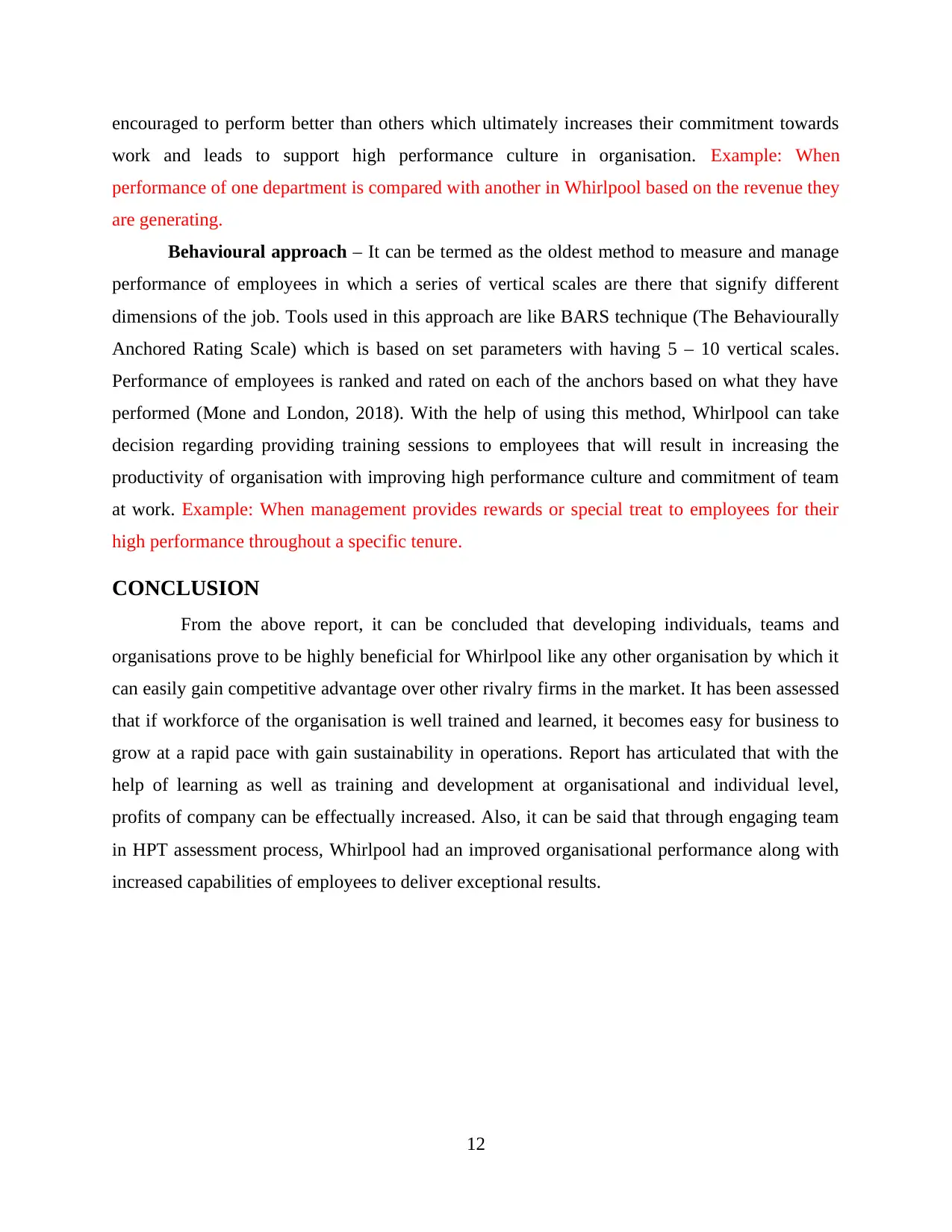
encouraged to perform better than others which ultimately increases their commitment towards
work and leads to support high performance culture in organisation. Example: When
performance of one department is compared with another in Whirlpool based on the revenue they
are generating.
Behavioural approach – It can be termed as the oldest method to measure and manage
performance of employees in which a series of vertical scales are there that signify different
dimensions of the job. Tools used in this approach are like BARS technique (The Behaviourally
Anchored Rating Scale) which is based on set parameters with having 5 – 10 vertical scales.
Performance of employees is ranked and rated on each of the anchors based on what they have
performed (Mone and London, 2018). With the help of using this method, Whirlpool can take
decision regarding providing training sessions to employees that will result in increasing the
productivity of organisation with improving high performance culture and commitment of team
at work. Example: When management provides rewards or special treat to employees for their
high performance throughout a specific tenure.
CONCLUSION
From the above report, it can be concluded that developing individuals, teams and
organisations prove to be highly beneficial for Whirlpool like any other organisation by which it
can easily gain competitive advantage over other rivalry firms in the market. It has been assessed
that if workforce of the organisation is well trained and learned, it becomes easy for business to
grow at a rapid pace with gain sustainability in operations. Report has articulated that with the
help of learning as well as training and development at organisational and individual level,
profits of company can be effectually increased. Also, it can be said that through engaging team
in HPT assessment process, Whirlpool had an improved organisational performance along with
increased capabilities of employees to deliver exceptional results.
12
work and leads to support high performance culture in organisation. Example: When
performance of one department is compared with another in Whirlpool based on the revenue they
are generating.
Behavioural approach – It can be termed as the oldest method to measure and manage
performance of employees in which a series of vertical scales are there that signify different
dimensions of the job. Tools used in this approach are like BARS technique (The Behaviourally
Anchored Rating Scale) which is based on set parameters with having 5 – 10 vertical scales.
Performance of employees is ranked and rated on each of the anchors based on what they have
performed (Mone and London, 2018). With the help of using this method, Whirlpool can take
decision regarding providing training sessions to employees that will result in increasing the
productivity of organisation with improving high performance culture and commitment of team
at work. Example: When management provides rewards or special treat to employees for their
high performance throughout a specific tenure.
CONCLUSION
From the above report, it can be concluded that developing individuals, teams and
organisations prove to be highly beneficial for Whirlpool like any other organisation by which it
can easily gain competitive advantage over other rivalry firms in the market. It has been assessed
that if workforce of the organisation is well trained and learned, it becomes easy for business to
grow at a rapid pace with gain sustainability in operations. Report has articulated that with the
help of learning as well as training and development at organisational and individual level,
profits of company can be effectually increased. Also, it can be said that through engaging team
in HPT assessment process, Whirlpool had an improved organisational performance along with
increased capabilities of employees to deliver exceptional results.
12

REFERENCES
Books and Journals
Baldwin, M., 2016. Social work, critical reflection and the learning organization. Routledge.
Boahin, P. and Hofman, W.A., 2014. Perceived effects of competency-based training on the
acquisition of professional skills. International Journal of Educational Development.36.
pp.81-89.
Dixon, N.M., 2017. The organizational learning cycle: How we can learn collectively.
Routledge.
Hewison, A. and et.al., 2018. Leading with compassion in health care organisations: The
development of a compassion recognition scheme-evaluation and analysis. Journal of
health organization and management. 32(2). pp.338-354.
Kearney, R., 2018. Public sector performance: management, motivation, and measurement.
Routledge.
Lunenberg, M., Dengerink, J. and Korthagen, F., 2014. The professional teacher educator:
Roles, behaviour, and professional development of teacher educators. Springer Science
& Business Media.
Mone, E.M. and London, M., 2018. Employee engagement through effective performance
management: A practical guide for managers. Routledge.
North, K. and Kumta, G., 2018. Knowledge management: Value creation through organizational
learning. Springer.
Pareek, L.U. and Purohit, S., 2018. Training Instruments in HRD and OD. SAGE Publishing
India.
Rae, D., 2018. 16. Developing entrepreneurial leadership for sustainable organisations. Research
Handbook on Entrepreneurship and Leadership. p.374.
Sessa, V.I. and London, M., 2015. Continuous learning in organizations: Individual, group, and
organizational perspectives. Psychology Press.
Söderhjelm, T. and et.al., 2018. Academic leadership: management of groups or leadership of
teams? A multiple-case study on designing and implementing a team-based development
programme for academic leadership. Studies in Higher Education. 43(2). pp.201-216.
Wilke, W., Lisa Rossum, L. and Wouter Dirk Have, W.D., 2018. Successful implementation of
self-managing teams. Leadership in Health Services.
Online
Dey, A. and Giri, I., 2017. Approaches for measuring performance of employees. [Online].
Available through: <https://www.projectguru.in/publications/approaches-measuring-
performance-employees/>.
McLeod, S., 2017. Kolb's Learning Styles and Experiential Learning Cycle. [Online]. Available
through: <https://www.simplypsychology.org/learning-kolb.html>.
13
Books and Journals
Baldwin, M., 2016. Social work, critical reflection and the learning organization. Routledge.
Boahin, P. and Hofman, W.A., 2014. Perceived effects of competency-based training on the
acquisition of professional skills. International Journal of Educational Development.36.
pp.81-89.
Dixon, N.M., 2017. The organizational learning cycle: How we can learn collectively.
Routledge.
Hewison, A. and et.al., 2018. Leading with compassion in health care organisations: The
development of a compassion recognition scheme-evaluation and analysis. Journal of
health organization and management. 32(2). pp.338-354.
Kearney, R., 2018. Public sector performance: management, motivation, and measurement.
Routledge.
Lunenberg, M., Dengerink, J. and Korthagen, F., 2014. The professional teacher educator:
Roles, behaviour, and professional development of teacher educators. Springer Science
& Business Media.
Mone, E.M. and London, M., 2018. Employee engagement through effective performance
management: A practical guide for managers. Routledge.
North, K. and Kumta, G., 2018. Knowledge management: Value creation through organizational
learning. Springer.
Pareek, L.U. and Purohit, S., 2018. Training Instruments in HRD and OD. SAGE Publishing
India.
Rae, D., 2018. 16. Developing entrepreneurial leadership for sustainable organisations. Research
Handbook on Entrepreneurship and Leadership. p.374.
Sessa, V.I. and London, M., 2015. Continuous learning in organizations: Individual, group, and
organizational perspectives. Psychology Press.
Söderhjelm, T. and et.al., 2018. Academic leadership: management of groups or leadership of
teams? A multiple-case study on designing and implementing a team-based development
programme for academic leadership. Studies in Higher Education. 43(2). pp.201-216.
Wilke, W., Lisa Rossum, L. and Wouter Dirk Have, W.D., 2018. Successful implementation of
self-managing teams. Leadership in Health Services.
Online
Dey, A. and Giri, I., 2017. Approaches for measuring performance of employees. [Online].
Available through: <https://www.projectguru.in/publications/approaches-measuring-
performance-employees/>.
McLeod, S., 2017. Kolb's Learning Styles and Experiential Learning Cycle. [Online]. Available
through: <https://www.simplypsychology.org/learning-kolb.html>.
13
Secure Best Marks with AI Grader
Need help grading? Try our AI Grader for instant feedback on your assignments.
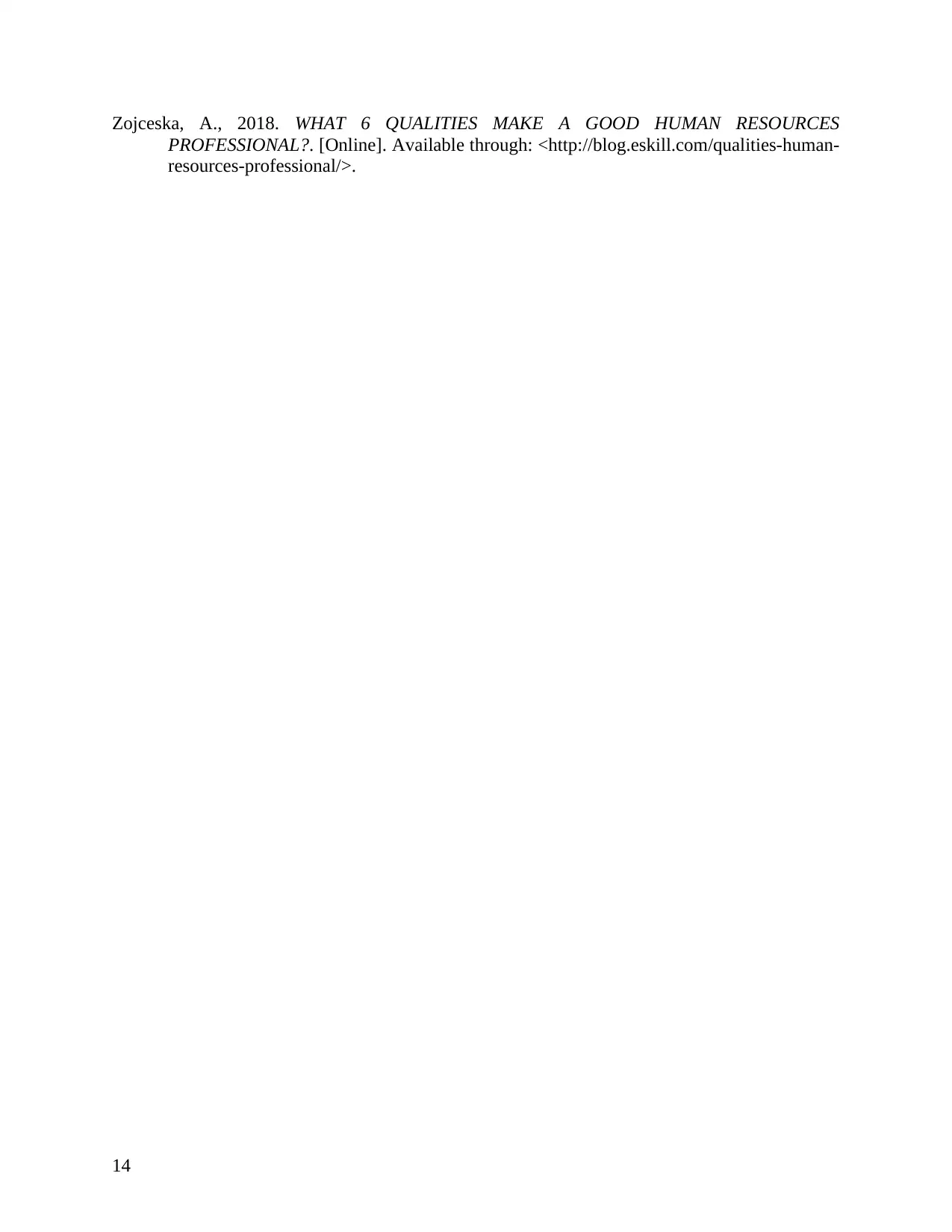
Zojceska, A., 2018. WHAT 6 QUALITIES MAKE A GOOD HUMAN RESOURCES
PROFESSIONAL?. [Online]. Available through: <http://blog.eskill.com/qualities-human-
resources-professional/>.
14
PROFESSIONAL?. [Online]. Available through: <http://blog.eskill.com/qualities-human-
resources-professional/>.
14
1 out of 17
Related Documents
Your All-in-One AI-Powered Toolkit for Academic Success.
+13062052269
info@desklib.com
Available 24*7 on WhatsApp / Email
![[object Object]](/_next/static/media/star-bottom.7253800d.svg)
Unlock your academic potential
© 2024 | Zucol Services PVT LTD | All rights reserved.





